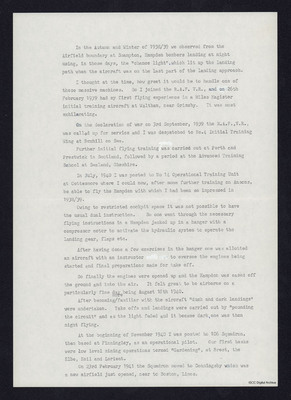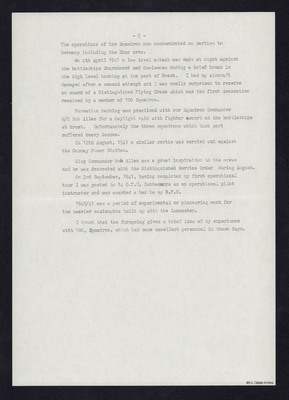Robert Wareing memoir
Title
Robert Wareing memoir
Description
Brief Resumé of Initial Flying Training and operational experiences on 106 Squadron, led by Wing Commander Bob Allen DSO with sorties against the Scharnhorst and Gneisenau Battleships in the Port of Brest.
Creator
Spatial Coverage
Language
Format
Two page printed document
Publisher
Rights
This content is available under a CC BY-NC 4.0 International license (Creative Commons Attribution-NonCommercial 4.0). It has been published ‘as is’ and may contain inaccuracies or culturally inappropriate references that do not necessarily reflect the official policy or position of the University of Lincoln or the International Bomber Command Centre. For more information, visit https://creativecommons.org/licenses/by-nc/4.0/ and https://ibccdigitalarchive.lincoln.ac.uk/omeka/legal.
Contributor
Identifier
BWareingRWareingRv1
Transcription
Start of transcription
In the Autumn and Winter of 1938/39 we observed from the Airfield boundary at Scampton, Hampden bombers landing at night using, in those days, the “chance light”, which lit up the landing path when the aircraft was on the last part of the landing approach.
I thought at the time, how great it would be to handle one of these massive machines. So I joined the R.A.F. V.R., and on 26th February 1939 had my first flying experience in a Miles Magister initial training aircraft at Waltham, near Grimsby. It was most exhilarating.
On the declaration of war on 3rd September, 1939 the R.A.F., V.R., was called up for service and I was despatched to N0.4 Initial Training Wing at Bexhill on Sea.
Further initial flying training was carried out at Perth and Prestwick in Scotland, followed by a period at the Advanced Training School at Sealand, Cheshire.
In July, 1940 I was posted to No 14 Operational Training Unit at Cottesmore where I could now, after some further training on Ansons, be able to fly the Hampden with which I had been so impressed in 1938/39.
Owing to restricted cockpit space it was not possible to have the usual dual instruction. So one went through the necessary flying instructions in a Hampden jacked up in a hangar with a compressor motor to activate the hydraulic system to operate the landing gear, flaps etc.
After having done a few exercises in the hangar one was allotted an aircraft with an instructor to oversee the engines being started and final preparations made for take off.
So finally the engines were opened up and the Hampden was eased off the ground and into the air. It felt great to be airborne on a particularly fine day being august 18th 1940.
After becoming [inserted] more [/inserted] familiar with the aircraft “dusk and dark landings” were undertaken. Take offs and landings were carried out by “pounding the circuit” and as the light faded and it became dark, one was then night flying.
At the beginning of November 1940 I was posted to 106 Squadron, then based at Finningley, as an operational pilot. Our first tasks were low level mining operations termed “Gardening”, at Brest, the Elbe, Keil and Lorient.
On 23rd February 1941 the Squadron moved to Conningsby which was a new airfield just opened, near Boston, Lincs.
[page break]
-2-
The operations of the Squadron now concentrated on sorties to Germany including the Rhur [sic] area.
On 4th April 1941 a low level attack was made at night against the battleship Sharnhorst [sic] and Gneisenau during a brief break in the high level bombing at the port of Brest. I had my aircraft damaged after a second attempt and I was really surprised to receive an award of a Distinguished Flying Cross which was the first decoration received by a member of 106 Squadron.
Formation bombing was practised with our Squadron commander W/C Bob Allen for a daylight raid with fighter escort on the battleships at Brest. Unfortunately the three squadrons which took part suffered heavy losses.
On 12th august, 1941 a similar sortie was carried out against the Gosnay Power Station.
Wing Commander Bob Allen was a great inspiration to the crews and he was decorated with the Distinguished service order during August.
On 3rd September, 1941, having completed my first operational tour I was posted to 14 O.T.U. Cottesmore as an operational pilot instructor and was awarded a bar to my D.F.C.
1940/41 was a period of experimental or pioneering work for the heavier onslaughts built up with the Lancaster.
I trust that the foregoing gives a brief idea of my experience with 106, Squadron, which had some excellent personnel in those days.
End of transcription
In the Autumn and Winter of 1938/39 we observed from the Airfield boundary at Scampton, Hampden bombers landing at night using, in those days, the “chance light”, which lit up the landing path when the aircraft was on the last part of the landing approach.
I thought at the time, how great it would be to handle one of these massive machines. So I joined the R.A.F. V.R., and on 26th February 1939 had my first flying experience in a Miles Magister initial training aircraft at Waltham, near Grimsby. It was most exhilarating.
On the declaration of war on 3rd September, 1939 the R.A.F., V.R., was called up for service and I was despatched to N0.4 Initial Training Wing at Bexhill on Sea.
Further initial flying training was carried out at Perth and Prestwick in Scotland, followed by a period at the Advanced Training School at Sealand, Cheshire.
In July, 1940 I was posted to No 14 Operational Training Unit at Cottesmore where I could now, after some further training on Ansons, be able to fly the Hampden with which I had been so impressed in 1938/39.
Owing to restricted cockpit space it was not possible to have the usual dual instruction. So one went through the necessary flying instructions in a Hampden jacked up in a hangar with a compressor motor to activate the hydraulic system to operate the landing gear, flaps etc.
After having done a few exercises in the hangar one was allotted an aircraft with an instructor to oversee the engines being started and final preparations made for take off.
So finally the engines were opened up and the Hampden was eased off the ground and into the air. It felt great to be airborne on a particularly fine day being august 18th 1940.
After becoming [inserted] more [/inserted] familiar with the aircraft “dusk and dark landings” were undertaken. Take offs and landings were carried out by “pounding the circuit” and as the light faded and it became dark, one was then night flying.
At the beginning of November 1940 I was posted to 106 Squadron, then based at Finningley, as an operational pilot. Our first tasks were low level mining operations termed “Gardening”, at Brest, the Elbe, Keil and Lorient.
On 23rd February 1941 the Squadron moved to Conningsby which was a new airfield just opened, near Boston, Lincs.
[page break]
-2-
The operations of the Squadron now concentrated on sorties to Germany including the Rhur [sic] area.
On 4th April 1941 a low level attack was made at night against the battleship Sharnhorst [sic] and Gneisenau during a brief break in the high level bombing at the port of Brest. I had my aircraft damaged after a second attempt and I was really surprised to receive an award of a Distinguished Flying Cross which was the first decoration received by a member of 106 Squadron.
Formation bombing was practised with our Squadron commander W/C Bob Allen for a daylight raid with fighter escort on the battleships at Brest. Unfortunately the three squadrons which took part suffered heavy losses.
On 12th august, 1941 a similar sortie was carried out against the Gosnay Power Station.
Wing Commander Bob Allen was a great inspiration to the crews and he was decorated with the Distinguished service order during August.
On 3rd September, 1941, having completed my first operational tour I was posted to 14 O.T.U. Cottesmore as an operational pilot instructor and was awarded a bar to my D.F.C.
1940/41 was a period of experimental or pioneering work for the heavier onslaughts built up with the Lancaster.
I trust that the foregoing gives a brief idea of my experience with 106, Squadron, which had some excellent personnel in those days.
End of transcription
Collection
Citation
R Wareing, “Robert Wareing memoir,” IBCC Digital Archive, accessed November 14, 2024, https://ibccdigitalarchive.lincoln.ac.uk/omeka/collections/document/27746.
Item Relations
| Item: Robert Wareing's memoir | dcterms:relation | This Item |


